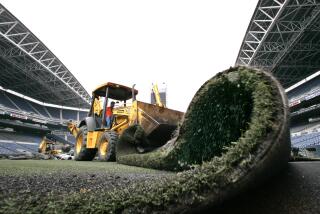Councilman Wants to Dump the Dumps
In the early days of Los Angeles, it was easy to get rid of garbage: People burned it in backyard incinerators. Or shipped it to ranches to feed hogs.
By the late 1950s, most of the city’s garbage was routed to landfills. About 940,000 tons of trash generated by the people of Los Angeles are buried in dumps each year. But now, most dumps are getting full -- and no one wants a new one built near them.
On Thursday, in a move intended to virtually eliminate the city’s dependence on landfills, Councilman Greig Smith introduced sweeping legislation calling for most of the city’s trash to instead be converted to methane gas, ethanol, compost or other products.
Smith argues that such technologies work in Europe and other parts of the world -- albeit on a much smaller scale -- but could be successful in Los Angeles while producing trace amounts of byproducts.
He said it won’t be surprising if opponents resist having the trash plants built anywhere near their homes.
“One of the big problems in America is that we’ve had the same concept -- we look at trash as a problem to be disposed of, to dig a hole in the ground and throw it in there,” Smith, a Republican from the San Fernando Valley, said in an interview Wednesday. “We want to move toward a new paradigm. We view trash as a resource, not as a problem, and I think that’s a paradigm shift that’s needed here in America.”
Of the 15 City Council members, it is unlikely that anyone knows more about trash than Smith. He was elected to the council in 2003, but had been chief deputy to Councilman Hal Bernson since 1980. His district includes Granada Hills, which sits below the giant Sunshine Canyon dump, where the bulk of the city’s garbage is buried.
Residents in Granada Hills have for years tried to get the dump closed. Smith, who lives in the area, years ago founded a group called Dump the Dump. Its efforts have failed.
But in dealing with residents, Smith has schooled himself in garbage technologies and was one of the writers of the 200-plus page report issued Thursday outlining the trash proposal.
Councilman Eric Garcetti called Smith’s report “the most impressive research proposal that I’ve seen in four years from any of my colleagues.” Garcetti has a reputation as the greenest member of the council; he spent a long weekend in April traveling to the Arctic for an Earth Day summit on global warming.
Smith doesn’t believe that his proposals, if enacted, would lead to the closure of Sunshine Canyon because the landfill is privately owned and serves other municipalities.
But landfills are increasingly in short supply in California. The world’s largest landfill, the Los Angeles County sanitation districts’ Puente Hills dump, is slated to close in 2013. No one wants to live near the old landfills, and getting a new one built has become extremely difficult.
“We have to acknowledge that landfills are just not going to be springing up everywhere anymore because there’s just too much public opposition,” said Patrick Mathews, a recycling and solid waste services manager for Santa Cruz County.
Using trash to produce energy is not a new idea. A plant in the City of Commerce has been burning trash since 1987, and the heat it generates creates enough electricity to power 10,000 homes. Likewise, methane gas that is a byproduct of treating sewage at Los Angeles’ Hyperion Wastewater Treatment Plant is used to produce energy.
Neighbors often oppose such plants because of the perception that they emit too many pollutants; in the 1980s, community activists killed the Lancer incineration project in South L.A. But Los Angeles County sanitation officials say that they have received few complaints about the Commerce plant, and that it is very clean because of stringent state and federal laws.
Smith wants the city to study emerging technologies that include using bacteria to break down garbage and converting trash to compost or ethanol. The ethanol, theoretically, could then be sold as a gasoline additive.
“What we don’t understand is the economic feasibilities, and how are we going to get around the opposition to these facilities,” said Bryan Jenkins, executive director of the California Biomass Collaborative and a biology and agricultural engineering professor at UC Davis.
Santa Cruz County also has examined waste-conversion technologies. A report issued by the county last year found significant benefits, but potentially serious problems with the emission of small levels of dioxins and heavy metals.
That report also found that it might be difficult to sell compost derived from trash because of trace amounts of contaminants.
And there’s the cost. Los Angeles spends about $24 to dispose of a ton of trash at Sunshine Canyon; more advanced technologies could cost twice that. The hope is to offset the cost by selling energy or materials produced by garbage.
In the meantime, free trash pickup from single-family homes costs the city $209 million annually. Last month, the council discussed charging residents, as other cities do, but no decision has been made.
The biggest question will be the placement of any new plants. The report says facilities would be equally distributed around the city, with one each in South Los Angeles, the Westside, the harbor area, North-Central, the East Valley and the West Valley, with one site to be determined.
Councilwoman Jan Perry, who represents downtown L.A. and parts of South Los Angeles, said she would consider supporting a plant for her district, although it’s inevitable that opponents will fight the plants.
More to Read
Sign up for Essential California
The most important California stories and recommendations in your inbox every morning.
You may occasionally receive promotional content from the Los Angeles Times.










